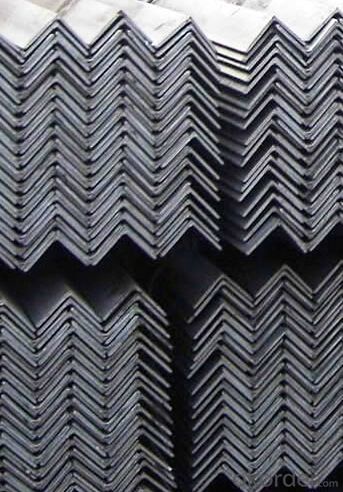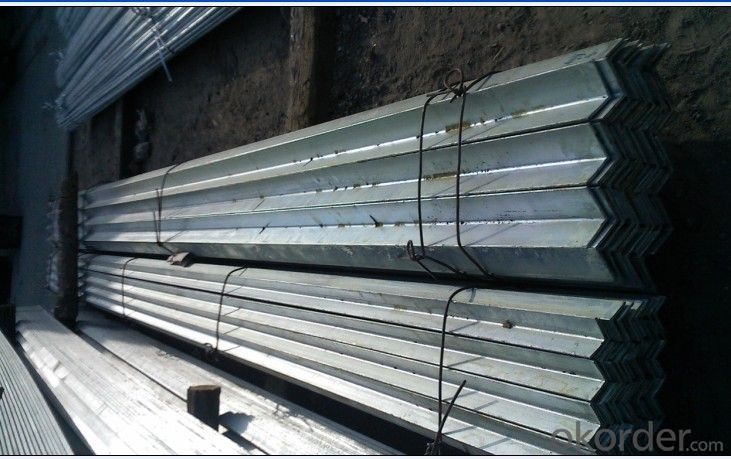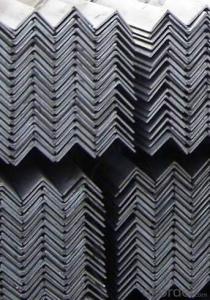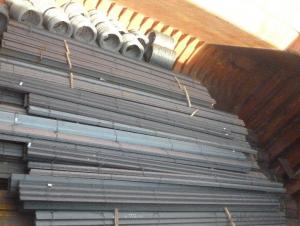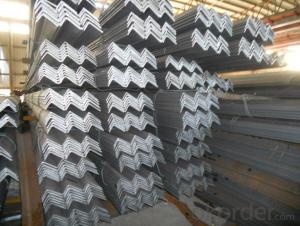Hot Rolled Low Carbon Steel Equal Angle Bars
- Loading Port:
- Tianjin
- Payment Terms:
- TT or LC
- Min Order Qty:
- 100 m.t.
- Supply Capability:
- 20000 m.t./month
OKorder Service Pledge
OKorder Financial Service
You Might Also Like
OKorder is offering Hot Rolled Low Carbon Steel Equal Angle Bars at great prices with worldwide shipping. Our supplier is a world-class manufacturer of steel, with our products utilized the world over. OKorder annually supplies products to African, South American and Asian markets. We provide quotations within 24 hours of receiving an inquiry and guarantee competitive prices.
Product Applications:
Hot Rolled Low Carbon Steel Equal Angle Bars are ideal for structural applications and are widely used in the construction of buildings and bridges, and the manufacturing, petrochemical, and transportation industries
Product Advantages:
OKorder's Hot Rolled Low Carbon Steel Equal Angle Bars are durable, strong, and wide variety of sizes.
Main Product Features:
· Premium quality
· Prompt delivery & seaworthy packing (30 days after receiving deposit)
· Can be recycled and reused
· Mill test certification
· Professional Service
· Competitive pricing
Product Specifications:
Manufacture: Hot rolled
Grade: Q195 – 235
Certificates: ISO, SGS, BV, CIQ
Length: 6m – 12m, as per customer request
Packaging: Export packing, nude packing, bundled
EQUAL ANGLES SIZES |
| ||
a(mm) | a1(mm) | thickness(mm) | length |
25 | 25 | 2.5---3.0 | 6M/12M |
30 | 30 | 2.5---4.0 | 6M/12M |
38 | 38 | 2.5 | 6M/12M |
38 | 38 | 3.0---5.0 | 6M/12M |
40 | 40 | 3.0---6.0 | 6M/12M |
50 | 50 | 3 | 6M/12M |
50 | 50 | 3.7---6.0 | 6M/9M/12M |
60 | 60 | 5.0---6.0 | 6M/9M/12M |
63 | 63 | 6.0---8.0 | 6M/9M/12M |
65 | 65 | 5.0---8.0 | 6M/9M/12M |
70 | 70 | 6.0---7.0 | 6M/9M/12M |
75 | 75 | 5.0---10.0 | 6M/9M/12M |
80 | 80 | 6.0---10.0 | 6M/9M/12M |
90 | 90 | 6.0---10.0 | 6M/9M/12M |
100 | 100 | 6.0---12.0 | 6M/9M/12M |
120 | 120 | 8.0-12.0 | 6M/9M/12M |
125 | 125 | 8.0---12.0 | 6M/9M/12M |
130 | 130 | 9.0-12.0 | 6M/9M/12M |
140 | 140 | 10.0-16.0 | 6M/9M/12M |
150 | 150 | 10---15 | 6M/9M/12M |
160 | 160 | 10---16 | 6M/9M/12M |
180 | 180 | 12---18 | 6M/9M/12M |
200 | 200 | 14---20 | 6M/9M/12M |
FAQ:
Q1: Why buy Materials & Equipment from OKorder.com?
A1: All products offered byOKorder.com are carefully selected from China's most reliable manufacturing enterprises. Through its ISO certifications, OKorder.com adheres to the highest standards and a commitment to supply chain safety and customer satisfaction.
Q2: How do we guarantee the quality of our products?
A2: We have established an advanced quality management system which conducts strict quality tests at every step, from raw materials to the final product. At the same time, we provide extensive follow-up service assurances as required.
Q3: How soon can we receive the product after purchase?
A3: Within three days of placing an order, we will arrange production. The normal sizes with the normal grade can be produced within one month. The specific shipping date is dependent upon international and government factors, the delivery to international main port about 45-60days.
Q4: How many tons of steel products could be loaded in containers?
A4: Usually the steel products are delivered by bulk vessel because of the large quantity and the freight. However, there are no bulk vessel enter some seaports so that we have to deliver the cargo by containers. The 6m steel product can be loaded in 20FT container, but the quantity is changed according to the size, usually from 18tons to 25tons.
Images:
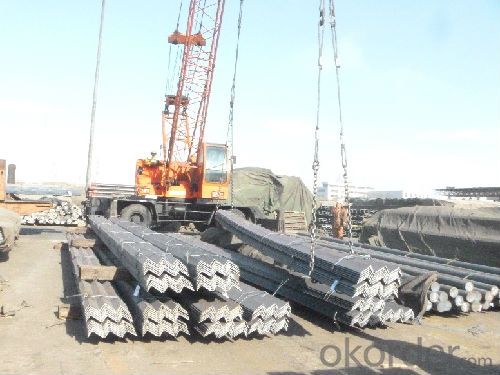
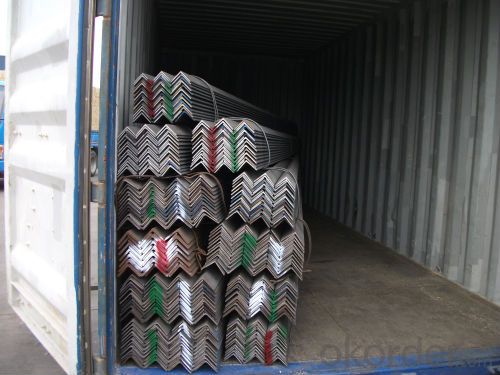
- Q: Can steel angles be used in staircases?
- Steel angles are indeed suitable for use in staircases. Due to their strength and versatility, they are commonly employed as structural components in construction. In staircases, steel angles serve to offer support and stability to both the steps and handrails. They are frequently utilized as stringers, inclined structural members that uphold the treads and risers of the staircase. Moreover, steel angles can be utilized to reinforce the connections between the treads and risers, thereby ensuring the staircase's structural integrity. Furthermore, steel angles can function as handrails or balusters, providing a secure and long-lasting railing system. All in all, steel angles present a dependable and cost-effective solution for constructing staircases that can withstand heavy loads and meet the necessary safety standards.
- Q: Can steel angles be used as handrails or guardrails?
- Handrails or guardrails can indeed be made using steel angles. The strength and durability of steel angles make them a popular choice in construction and industrial settings. When designed, fabricated, and installed correctly, steel angles offer a dependable support system for handrails and guardrails. By welding or bolting them to other structural components, a secure and safe railing system can be created. Moreover, steel angles are easily customizable to match specific design and aesthetic preferences. However, it is crucial to verify that the steel angles used adhere to the necessary safety standards and building codes, ensuring the safety and well-being of those utilizing the handrails or guardrails.
- Q: Are there any special considerations when handling or installing steel angles?
- Yes, there are several special considerations when handling or installing steel angles. Firstly, it is important to ensure that the angles are properly stored and protected from corrosion. They should be kept in a dry and well-ventilated area, away from moisture and chemicals. Secondly, during installation, it is crucial to carefully measure and mark the location of the angles to ensure accurate placement. Additionally, proper safety precautions should be taken, such as wearing protective gloves and goggles, as steel angles can be heavy and have sharp edges. Lastly, it is important to follow the manufacturer's guidelines and recommendations for installation to ensure structural integrity and safety.
- Q: How do you calculate the effective length of a steel angle?
- To calculate the effective length of a steel angle, you need to consider two main factors: the actual length of the angle and the stability of the angle's supported members. Firstly, determine the actual length of the steel angle. This can be measured physically or obtained from the specifications provided by the manufacturer. Ensure that you have the accurate length value for the calculation. Next, assess the stability of the angle's supported members. The effective length of the angle is influenced by the conditions under which it is being used and supported. There are three primary support conditions to consider: pinned-pinned, fixed-fixed, and fixed-pinned. For a pinned-pinned support condition, the effective length is equal to the actual length of the angle. This condition assumes that both ends of the angle can freely rotate, resulting in the full length being effective in resisting the applied loads. In a fixed-fixed support condition, the effective length is typically considered as 0.7 times the actual length. This condition assumes that both ends of the angle are rigidly connected, reducing the effective length due to the increased stiffness of the overall system. For a fixed-pinned support condition, the effective length is usually 0.85 times the actual length. In this case, one end of the angle is fixed while the other end can freely rotate, resulting in a reduced effective length compared to the actual length. It is essential to correctly determine the support conditions of the steel angle to accurately calculate its effective length. Additionally, other factors like the angle's material properties, cross-section, and loading conditions should be considered in a comprehensive analysis of the angle's behavior.
- Q: What is the keel of the aluminum single board suspended or the welded frame of angle steel?
- Aluminum curtain wall veneer made of high strength Aluminum Alloy plate, its structure is mainly composed of a panel, stiffener and bracket component. Code can be directly by the panel bending, stamping molding, but also in the panel on the hems of riveting corner molding. The reinforcing ribs and the plate after the welding nail connection, make it become a strong overall, greatly enhance the rigidity and strength of single aluminum plate curtain wall, to ensure the long-term use of smoothness and anti-seismic capability. A lot of single plate shaped type, is also the largest, others with no keel, the ceiling of the room is generally used with plate, steel keel, length of 3 meters
- Q: What is the typical corrosion resistance of steel angles?
- The typical corrosion resistance of steel angles can vary depending on the specific grade of steel used and the environmental conditions in which they are exposed. However, in general, steel angles have a moderate to high level of corrosion resistance due to the presence of alloying elements such as chromium, nickel, and molybdenum. These elements form a protective oxide layer on the surface of the steel, which helps to prevent further corrosion. Additionally, the use of coatings or treatments such as galvanization or painting can further enhance the corrosion resistance of steel angles. Ultimately, it is important to consider the specific application and environment in order to select the appropriate grade of steel angle with the desired level of corrosion resistance.
- Q: Can steel angles be cut to custom lengths?
- Yes, steel angles can be cut to custom lengths. Steel angles, also known as angle irons, are versatile structural components commonly used in construction and manufacturing. They are available in various standard sizes, but they can also be customized to meet specific length requirements. This can be achieved by using cutting tools such as saws or shears to trim the steel angle to the desired length. The ability to cut steel angles to custom lengths makes them suitable for a wide range of applications, as they can be tailored to fit specific design needs.
- Q: Can steel angles be used in playground or recreational equipment?
- Absolutely! Playground or recreational equipment can definitely make use of steel angles. Steel angles are incredibly versatile and sturdy as a structural material, making them perfect for a wide range of purposes in playground or recreational equipment. They offer stability, support, and long-lasting durability, which makes them ideal for use in various structures like climbing frames, swing sets, slides, and other equipment. Given their ability to withstand heavy loads, impact forces, and even harsh weather conditions, steel angles are often used to create frames, posts, and supports in playground equipment. What's great is that these angles can be easily customized and fabricated to meet specific design requirements, ensuring that the equipment is both safe and functional.
- Q: What are the different standards for steel angles?
- Steel angles, commonly used in construction and industrial applications, adhere to various standards to meet specific requirements. The American Society for Testing and Materials (ASTM) standard, specifically ASTM A36, is widely recognized and specifies the chemical composition, mechanical properties, and tolerances of steel angles. This standard is suitable for general structural purposes and is available in different sizes and lengths. Similarly, the European standard, known as EN 10025, encompasses multiple grades of steel angles, including S235, S275, and S355, which correspond to different yield strengths. These angles find extensive use in construction, machinery, and engineering industries throughout Europe. Country-specific standards also exist, such as the Japanese Industrial Standards (JIS) and the British Standards (BS). JIS G3101, a renowned standard in Japan, outlines the specifications for hot-rolled steel angles used in general structures. Meanwhile, BS EN 10056, a British standard, provides specifications for steel angles employed in construction. Furthermore, specialized standards cater to specific applications, such as marine-grade steel angles that withstand corrosion in saltwater environments. These standards, like ASTM A588, impose additional requirements for chemical composition and mechanical properties to ensure durability in harsh conditions. In conclusion, the diversity of steel angle standards guarantees that these structural shapes fulfill precise requirements regarding strength, durability, and compatibility with various construction and industrial applications. To ensure compliance with necessary specifications, it is crucial to consult the appropriate standard when selecting steel angles.
- Q: How are steel angles installed on concrete structures?
- To reinforce and support concrete structures, steel angles are commonly utilized. The installation of steel angles on concrete structures entails several steps. To begin, the concrete surface must be prepared. This entails thoroughly cleaning the surface and eliminating any debris or loose material. The concrete must be in good condition, devoid of cracks or other structural problems. Next, the steel angles must be positioned and marked on the concrete surface. Typically, a measuring tape and chalk line are used for this purpose. Based on the structural requirements, the angles are usually placed at specific intervals and locations. Once the positions have been marked, the concrete surface needs to be drilled. This is accomplished using a drill and a masonry bit appropriate for the size of the anchor bolts or fasteners that will be employed. It is crucial to drill the holes to the required depth to ensure a secure and stable installation. After the holes have been drilled, anchor bolts or fasteners are inserted into them. These bolts or fasteners are specifically designed for securely fastening steel angles to concrete surfaces. Usually made of steel, they possess a threaded end that enables them to be firmly tightened into the concrete. Once the anchor bolts or fasteners have been inserted, the steel angles are positioned and aligned with the marked locations on the concrete surface. The angles are then secured to the concrete by tightening the nuts on the anchor bolts or fasteners. Finally, the installation is examined for accuracy and stability. The angles should be securely attached to the concrete surface and should not move or shift when pressure is applied. Additional adjustments or tightening may be necessary to ensure a dependable and secure installation. All in all, the process of installing steel angles on concrete structures involves meticulous preparation, drilling, anchoring, and securing. This guarantees that the angles deliver the necessary strength and support required for the specific application.
Send your message to us
Hot Rolled Low Carbon Steel Equal Angle Bars
- Loading Port:
- Tianjin
- Payment Terms:
- TT or LC
- Min Order Qty:
- 100 m.t.
- Supply Capability:
- 20000 m.t./month
OKorder Service Pledge
OKorder Financial Service
Similar products
Hot products
Hot Searches
Related keywords




